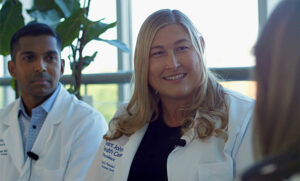The Margie Petersen Breast Center provides a variety of services from routine examination to oncologic treatment, starting with our breast clinic. Women can take a proactive role in their breast health by conducting self examinations and our physicians can confirm results with a clinical breast exam.
What is a Clinical Breast Examin (CBE)?
A clinical breast exam is a physical exam of your breasts that is performed by a health care provider. Aside from your BSEs, a CBE should be part of your yearly medical check-up. At the Margie Petersen Breast Center at Saint John’s, we work diligently to provide answers to your questions as quickly as possible in our breast clinic.
How often should a clinical breast exam be performed?
Patients should have a clinical breast exam every three years in their 20s and 30s and annually after age 40. This frequency helps detect changes or abnormalities in the breasts early. Regular exams are crucial for breast health and effective cancer care. If you have a higher risk due to family history or other factors, your healthcare provider might recommend more frequent exams. Discussing your health history with your provider ensures personalized advice. Staying consistent with these exams supports early detection and better outcomes in breast cancer care.
CBEs by Age
Women age 40 and older should have an annual clinical breast exam in addition to their annual mammogram, while women in their 20s and 30s should have a clinical breast exam (CBE) every three years. A CBE offers a chance for women and their healthcare provider to discuss any changes to their breasts, consider screening recommendations, and discuss risk factors such as health and family history that could make breast cancer more or less of a concern.
Breast screening methods
Screening is the next step of the evaluation process if something suspicious is found in or around the breast. Not all conditions are cancer-related, but it is important to know the difference sooner than later, taking additional steps if necessary. Breast screening typically includes ultrasound imaging. This method provides a quick view of the breast structures to rule out some conditions effectively. For additional clarity, a mammogram may be recommended, which uses X-ray technology to assess dense breast material better. Most women receive annual mammograms as part of their physicals.
Though less common, breast Magnetic Resonance Imaging (MRI) provides very detailed pictures of areas in the breast. A breast MRI is typically recommended to determine the extent of cancer after a breast cancer diagnosis, including determining whether the cancer has spread to the underlying muscles or if there is a suspicion of affected lymph nodes. It may also be used to confirm the extent of surgery for a tumor but is generally needed to evaluate breast abnormalities that are difficult to assess with mammography and breast ultrasound.
If, after screening, there is a high suspicion of cancer, a breast biopsy will be performed, which entails collecting a small amount of tissue or fluid from the breast so that it can be analyzed further. A pathologist defines the cancer type, indicating the course of treatment needed.
Breast Self-Examination (BSE)

Breast self-examination is recommended once a month for women of any age. Performing a breast self-examination can help you become familiar with how breasts normally look and feel, which improves your ability to identify changes in one or both breasts. Like all health concerns, discussing any breast changes with your provider for further evaluation and risk assessment is important.
Breast self-exams are crucial for early detection of breast cancer, which significantly increases the chances of successful treatment and survival. While BSEs are not a substitute for regular mammograms or clinical breast examinations, they are vital in early detection, particularly for women under 40 who may not have regular mammograms.
How do I do a breast self-examination?
Thankfully, a breast self-exam may be the easiest thing you can do to have the greatest impact on your health. It involves a systematic approach to feeling and observing the breasts. Add a reminder to your schedule to do the self-exam, ideally two weeks before your menstrual period or a few days after it ends, when the breasts are less likely to be tender or swollen.
To begin, stand in front of a mirror with your hands on your hips and visually inspect your breasts for any changes in size, shape, or contour. Look for dimpling, puckering, or changes in skin texture. Next, raise your arms and look for the same changes.
For the palpation part of the exam, lie down and place a pillow under your right shoulder. Use your left hand to feel your right breast in small circular motions, moving from the outside to the center, checking the entire breast and armpit area. Use light, medium, and firm pressure to feel different depths of breast tissue. Repeat the process for the left breast using your right hand.
During the breast exam, look for changes such as lumps or thickening of the breast tissue, swelling, warmth, redness, or darkening of the breast, changes in the size or shape of the breast, or dimpling or puckering of the skin. Nipple discharge, especially if it contains blood, should also be noted. While these changes can be caused by factors other than cancer, any persistent breast changes should be evaluated by a healthcare professional.

What are the signs to look for in a breast self-exam?
- A change in size or shape of your breast
- Any swelling, redness, darkening, or warmth of your breast
- Sudden or unexpected nipple discharge
- A rash, skin lesion, or dimpling of any area of your breast
- Pain in your breast within a focused area
- A sudden inversion of your nipple (returns to the inverted state even when corrected)
- A lump and/or hardening of your breast
What does a lump in your breast feel like?
A lump in your breast can feel like a distinct mass different from the surrounding tissue. It might be hard or soft, smooth or irregular, and can vary in size. Sometimes, lumps are painless, while others may cause discomfort. Not all lumps are cancerous, but any new or unusual breast changes should be evaluated by a healthcare provider. Early detection is crucial for effective cancer care. Regular self-exams and clinical exams are important for maintaining breast health and identifying potential issues early. If you find a lump, consult your provider promptly for a thorough evaluation.
Do I still need an annual mammogram?
While BSEs are valuable, they are not foolproof. Not all breast cancers can be detected through self-exams, and some benign breast conditions can mimic cancer. Therefore, it’s important to combine self-exams with regular clinical breast exams and mammograms, as your healthcare provider recommends, to maximize the chances of early detection and successful treatment.
What is the most accurate breast exam?
A mammogram is the most accurate breast exam for detecting abnormalities. This imaging test can identify changes in breast tissue that are too small to be felt. Regular mammograms are crucial for early detection and effective cancer care. For those with dense breasts, additional tests like ultrasound or MRI might be recommended for more accurate results. Discussing your health history and risk factors with your provider ensures you receive the best screening approach. Combining regular mammograms with clinical exams and self-exams enhances breast health and helps in early detection of potential issues.
Breast Cancer Screening Methods and Myths Webinar
Watch our breast cancer doctors at the Margie Petersen Breast Center at Providence Saint John’s, discuss the different types of breast cancer screening methods including breast exams, mammography, ultrasounds, MRI, and biopsy, as well as share the facts for all the common breast cancer myths you’ve heard.
Janie Grumley, MD, FACS, Breast Surgical Oncologist and Director, Comprehensive Breast Program, Margie Petersen Breast Center provides a comprehensive overview of the issues and concerns patients may have.
Contact the Margie Petersen Breast Center

The Margie Petersen Breast Center at Providence Saint John’s Health Center is widely renowned for its outstanding and compassionate patient care, expert surgical and medical team, and ability to evaluate any breast condition in one day fully.
Meet Our Breast Health Experts
The Breast Health Clinic can be reached at (310) 582-7209. If you have questions regarding a new symptom or want to make an appointment for evaluation please call and a staff member will assist with navigating you in the right direction.
More Breast Cancer Webinars
Watch our breast cancer webinars to learn about screenings, treatment options, oncoplastic surgery, IORT, and much more! The Ken Johnson family generously provides funding for these educational webinars in memory of Joan Brierton Johnson.






